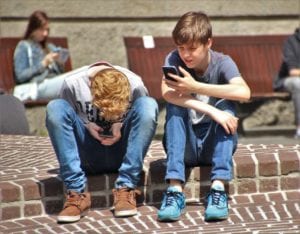Written by Jessica Patella, ND. A cross sectional study of cell phone use among Chinese children indicates a significant association between fatigue and headaches in children and their cell phone usage.
 Cell phones are now used by most people and the average age for children to own their first cell phone is only 10.3 years of age 1,2. For children the cell phone is not only for communicating with family and friends, it is also used as a source of entertainment, such as playing games and surfing the Internet 1. Recent research has found that cell phone use in children is associated with increased fatigue and headaches 1.
Cell phones are now used by most people and the average age for children to own their first cell phone is only 10.3 years of age 1,2. For children the cell phone is not only for communicating with family and friends, it is also used as a source of entertainment, such as playing games and surfing the Internet 1. Recent research has found that cell phone use in children is associated with increased fatigue and headaches 1.
The safety of cell phone use has been debated and researched since cell phone usage began. The question is if children are more vulnerable to the electromagnetic fields because of their developing nervous system, thinner skulls and earlier and longer exposure leading to greater accumulated risk 1,3,4.
The research included two primary schools in China that participated in the study. A total of 793 questionnaires were given to fifth grade students. Students filled out the questionnaires in the presence of their class teacher and could ask questions if there was something they did not understand. A total of 746 questionnaires (94.1%) were valid and included in the final analysis 1.
The questionnaires had four parts: demographic information, information on cell phone usage, self-reported physical symptoms and possible confounding factors. The part of the questionnaire regarding cell phone usage included questions on cell phone ownership, years of cell phone usage and daily duration of cell phone calls 1.
The following observations were made:
- 72.9% owned cell phones
- Average years of usage was 1.3 +/- 1.5 years
- 53.4% spent less than 10 minutes on calls per day
- The most frequently reported physical symptom was sleep problems (17.8%)
- The second most commonly reported symptoms was fatigue (13.9%)
- The third most commonly reported symptom was dizziness (12.7%)
- Fatigue was significantly associated with both the years of cell phone usage (OR 1.79; 95% CI 1.07-3.00, P=0.010) and the daily duration of cell phone calls (OR 2.54; 95% CI 1.27-5.05. P=0.025)
- Children with the highest level of daily duration calls felt headache significantly more than did those at other levels; however, the association between headache and MP use was not statistically significant after adjusting for confounding factors. This is one of the first studies to investigate the potential association between cell phone usage and well-being in children in China.
This was a correlation study and future research might consider collecting the cell phone usage logs from the cell phone company to measure individual exposure. In conclusion, this study indicates a significant association between fatigue and headaches in children and their cell phone usage 1. In depth research still needs to be conducted. It should be noted that teachers were observing all the students and there might be conformity effect. It would also be important to look at other countries to see if there are cultural differences, as well as, if cell phone usage such as text messages and time on social media also makes a difference, not just phone call time.
Source: Zheng, Feizhou, Peng Gao, Mindi He, Min Li, Jin Tan, Daiwei Chen, Zhou Zhou, Zhengping Yu, and Lei Zhang. “Association between mobile phone use and self-reported well-being in children: a questionnaire-based cross-sectional study in Chongqing, China.” BMJ open 5, no. 5 (2015): e007302.Creative Commons Attribution Non Commercial (CC BY-NC 4.0) license. http://creativecommons.org/licenses/by-nc/4.0/
Click here to read the full text study.
Posted April 2, 2018.
References:
- Zheng F, Gao P, He M, et al. Association between mobile phone use and self-reported well-being in children: a questionnaire-based cross-sectional study in Chongqing, China. BMJ open. 2015;5(5):e007302.
- Byun Y-H, Ha M, Kwon H-J, et al. Epidemiological characteristics of mobile phone ownership and use in Korean children and adolescents. Environmental health and toxicology. 2013;28.
- Söderqvist F, Carlberg M, Mild KH, Hardell L. Childhood brain tumour risk and its association with wireless phones: a commentary. Environmental Health. 2011;10(1):106.
- Stewart W. Independent Expert Group on Mobile Phones (IEGMP) Mobile Phones and Health. Chilton: National Radiological Protection Board, UK. 2000.

